The Burden of Massive EV Batteries Will Be Borne by People and Ecosystems
Much of the excitement over the Inflation Reduction Act, which became law this summer, focused on the boost it should give to the sales of electric vehicles. Sadly, though, manufacturing and driving tens of millions of individual electric passenger cars won’t get us far enough down the road to ending greenhouse-gas emissions and stanching the overheating of this planet. Worse yet, the coming global race to electrify the personal vehicle is likely to exacerbate ecological degradation, geopolitical tensions, and military conflict.
The batteries that power electric vehicles are likely to be the source of much international competition and the heart of the problem lies in two of the metallic elements used to make their electrodes: cobalt and lithium. Most deposits of those metals lie outside the borders of the United States and will leave manufacturers here (and elsewhere) relying heavily on foreign supplies to electrify road travel on the scale now being envisioned.
Adventurers and Opportunists
In the battery business, the Democratic Republic of Congo is referred to as “the Saudi Arabia of cobalt.” For two decades, its cobalt — 80% of the world’s known reserves — has been highly prized for its role in mobile-phone manufacturing. Such cobalt mining has already taken a terrible human and ecological toll.
Now, the pressure to increase Congo’s cobalt output is intensifying on a staggering scale. Whereas a phone contains just thousandths of a gram of cobalt, an electric vehicle battery has pounds of the metal, and a quarter-billion such batteries will have to be manufactured to fully electrify the American passenger car fleet as it now exists.
Not surprisingly, the investment world is now converging on Congo’s capital, Kinshasa. In a remarkable series of articles late last year, the New York Times reported on how the cobalt rush in that country has been caught up “in a familiar cycle of exploitation, greed, and gamesmanship that often puts narrow national aspirations above all else.” The most intense rivalry is between China, which has, in recent years, been buying up cobalt-mining operations in Congo at a rapid clip, and the United States, now playing catch-up. Those two nations”, wrote the Times, “have entered a new ‘Great Game’ of sorts,” a reference to the nineteenth-century confrontation between the Russian and British Empires over Afghanistan.
Fifteen of 19 cobalt mines in Congo are now under Chinese control. In and around those mines, the health and the safety of workers have been severely compromised, while local residents have been displaced from their homes. People sneaking into the area to collect leftover lumps of cobalt to sell are being shot at. The killing of one man by the Congolese military (at the urging of Chinese mine owners) spurred an uprising in his village, during which a protester was also shot and killed.
The Times further reported, “Troops with AK-47s were posted outside the mine this year, along with security guards hired from a company founded by Erik Prince.” Prince is notorious for having been the founder and boss of the mercenary contractor Blackwater, which committed atrocities during America’s “forever wars” of the 2000s. Among other mayhem, Blackwater mercenaries fired upon unarmed civilians in both Iraq and Afghanistan and were convicted of the killings and woundings that resulted. From 2014 to 2021, he was the chair of a China-based company, Frontier Services Group, that provided Blackwater-style services to mining companies in Congo.
Prince has joined what the Times calls “a wave of adventurers and opportunists who have filled a vacuum created by the departure of major American mining companies, and by the reluctance of other traditional Western firms to do business in a country with a reputation for labor abuses and bribery.”
(… )
While evidently uninterested in Mother Nature, Tesla’s electric car tycoon Elon Musk is intensely interested in vertically integrating lithium mining with electric battery and vehicle production on the Chinese model. Accordingly, he’s been trying for years to get his hands on Bolivia’s pristine lithium reserves. Until ousted in a 2020 coup, that country’s president Evo Morales stood in Musk’s way, pledging to “industrialize with dignity and sovereignty.”
When a Twitter user accused Musk of being complicit in the coup, the Tesla tycoon responded, “We will coup whoever we want! Deal with it.” (He later deleted the tweet.) As Vijay Prashad and Alejandro Bejarano observed at the time, “Musk’s admission, however intemperate, is at least honest… Earlier this year, Musk and his company revealed that they wanted to build a Tesla factory in Brazil, which would be supplied by lithium from Bolivia; when we wrote about that we called our report ‘Elon Musk Is Acting Like a Neo-Conquistador for South America’s Lithium.”
Bolivia continues to seek to exploit its lithium resources while keeping them under national control. Without sufficient wealth and technical resources, however, its government has been obliged to solicit foreign capital, having narrowed the field of candidate companies to six — one American, one Russian, and four Chinese. By year’s end, it’s expected to select one or more of them to form a partnership with its state-owned firm, Yacimientos de Litios Bolivianos. No matter who gets the contract, friction among the three suitor nations could potentially kick off a Western Hemispheric version of the Great Game (…)
Don’t Look Down
The greatest potential for conflict over battery metals may not, in fact, be in Asia, Africa, or the Americas. It may not be on any continent at all. The most severe and potentially most destructive future battleground may lie far out in international waters, where polymetallic nodules — dense mineral lumps, often compared to potatoes in their size and shape — lie strewn in huge numbers across vast regions of the deep-ocean floor. They contain a host of metallic elements, including not only lithium and cobalt but also copper, another metal required in large amounts for battery manufacturing. According to a United Nations report, a single nodule field, the 1.7 million-square-mile Clarion-Clipperton Zone (CCZ) in the Pacific Ocean southeast of the Hawaiian Islands, contains more cobalt than all terrestrial resources combined.
(…)
The Burden of the Big-Ass Truck
Systemic collapse? Really? Instead of devising technologies to take down other societies, in this increasingly heated moment, shouldn’t we be focusing on how to avoid our own systemic collapse?
A national fleet of battery-powered cars is unlikely to prove sustainable and could have catastrophic consequences globally. It’s time to consider an overhaul of the whole transportation system to move it away from a fixation on personal vehicles and toward walking, pedaling, and a truly effective nationwide public transportation system (as well as very local ones), which could indeed be run on electricity, while perhaps helping to avoid future disastrous resource wars.
Such a transformation, even were it to occur, would, of course, take a long time. During that period, electric vehicles will continue to be manufactured in quantity. So, for now, to reduce their impact on humanity and Earth, America should aim to produce fewer and far smaller vehicles than are currently planned. After all, electrified versions of the big-ass trucks and SUVs of the present moment will also require bigger, heavier batteries (like the one in the F-150 Lightning pickup truck, which weighs 1,800 pounds and is the size of two mattresses). They will, of course, contain proportionally larger quantities of cobalt, lithium, and copper.
The true burden of a massive battery in an electric car or truck will be borne not just by the vehicle’s suspension system, but by the people and ecosystems unlucky enough to be in or near the global supply chain that will produce it. And those people may be among the first of millions to be imperiled by a new wave of geopolitical and military conflicts in what should be thought of as the world’s green sacrifice zones.
Copyright 2022 Stan and Priti Cox
Read the whole article:
- Are Green Resource Wars Looming? – by Priti Gulati Cox and Stan Cox – tomdispatch.com, 13 okt 2022

